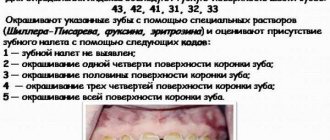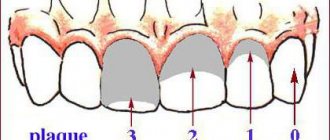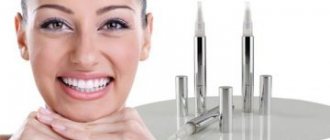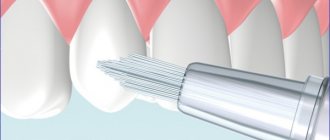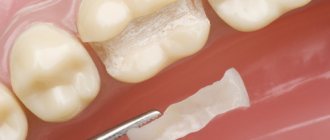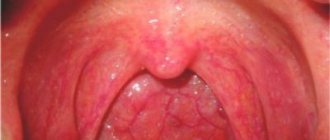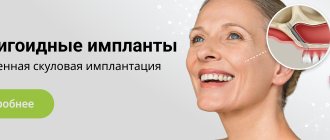Oral hygiene is one of the most accessible and at the same time one of the leading methods of preventing oral diseases. Regular and competent oral care is an integral part of all preventive measures. Mass population surveys conducted in all countries of the world have convincingly shown that systematic oral care has an undoubted preventive value. It is possible to objectively assess the level of oral hygiene only using hygiene indices.
To identify dental plaque in assessing oral hygiene in modern dentistry, objective indicators (indices) are used that characterize the quality and quantity of dental plaque. However, the number of assessment methods, which are based on different numbers of teeth from different functional groups, up to staining all teeth on both sides or collecting and weighing plaque around individual teeth, indicates the relevance of the problem under consideration and the imperfection of existing methods.
The formula will help determine the condition of the mouth
To determine the condition of the oral cavity in medicine, there are about 80 different hygiene indices, based on the principle of staining the enamel with a special solution and identifying dental plaque.
According to the parameters they define, indices can be classified into 4 groups, assessing:
- area affected by plaque;
- thickness of plaque on teeth;
- mass of plaque;
- other parameters of dental plaque (chemical, physical and microbiological).
KPI
CPI is a comprehensive periodontal index. You can start research from adolescence, analyzing the condition of teeth 17/16, 11, 26/27, 31, 36/37, 46/47.
KPI Index
For a full analysis, you need to provide high-quality lighting with lamps. Use the same equipment as usual.
Important! Some pathologies suggest serious injuries.
If the doctor is in doubt, it is necessary to conduct electroodontodiagnosis.
Electroodontodiagnosis
CPU in dentistry
Dentists should use these calculations during the initial examination of the patient. So, for example, the average values of the indices KPU, kp. KPU+KP of teeth and cavities in dentistry allows you to determine the intensity of carious lesions. These abbreviations contain the following meanings:
- K – carious permanent teeth;
- P – permanent teeth in which a filling is installed;
- U – extracted molars;
- j – temporary teeth affected by caries;
- p – filled temporary teeth.
- According to the World Health Organization, the average CP index for children 12 years old should be from 2.7 to 4.4, and for citizens aged 35-44 years 6.3-12.7.
Quality and safety
I, the subject of personal data, in accordance with the Federal Law of July 27, 2006 No. 152 “On Personal Data,” provide SCNT “NOVOSTOM” LLC: (hereinafter referred to as the Operator), located at 127030 Moscow, st. Novoslobodskaya, 24, building 4 (checkpoint 770701001), consent to the processing of personal data specified by me in the registration form and/or in the feedback form on the Internet site, owned by the Operator.
The personal data I provide is as follows: full name, email address and telephone number.
The purposes of processing my personal data are: ensuring the exchange of short text messages in online dialogue and ensuring the functioning of a call back.
Consent is provided to carry out the following actions (operations) with the personal data specified in this consent: collection, systematization, accumulation, storage, clarification (updating, changing), use, transfer (provision, access), blocking, deletion, destruction, carried out as with using automation tools (automated processing) and without the use of such tools (non-automated processing).
I understand and agree that providing the Operator with any information about myself that is not contact information and not related to the purposes of this consent, as well as providing information related to state, banking and/or commercial secrets, information about racial and/or nationality, political views, religious or philosophical beliefs, health status, intimate life are prohibited.
If I decide to provide the Operator with any information (any data), I undertake to provide only reliable and up-to-date information and do not have the right to mislead the Operator regarding my identity, or provide false or inaccurate information about myself.
I understand and agree that the Operator does not verify the accuracy of the personal data provided by me and is not able to assess my legal capacity and assumes that I provide reliable personal data and keep such data up to date.
Consent is valid upon achievement of the purposes of processing or in the event of the loss of the need to achieve these purposes, unless otherwise provided by federal law.
Consent may be withdrawn by me at any time based on my written statement.
Simplified index (IGR-U)
The Green Vermillion Hygiene Index measures plaque and tartar on the surfaces of the 2 upper first molars, 2 lower first molars and 2 upper incisors.
Ratings are given as follows:
- 0 – no plaque;
- 1 – no more than 1/3 of the tooth surface is covered with plaque;
- 2 – plaque affects from 1/3 to 2/3 of the tooth;
- 3 – dental plaque covers more than 2/3 of the surface.
The simplified hygienic index is calculated by adding the plaque index and tartar index on 6 teeth.
Examination of pregnant women
In order to achieve maximum effect in the prevention of dental diseases, it is necessary to coordinate the work of the dentist and gynecologist, as well as medical examination of women throughout pregnancy. In the dental office, doctors carry out:
- sanitation of the oral cavity;
- assistance in the selection of basic and additional hygiene products, training in rational oral care;
- professional hygiene;
- remineralizing therapy, which increases the resistance of tooth enamel.
PMA – papillary-alveolar-marginal index
When calculating the PMA index, a solution of iodine or Lugol is used, which is applied to the gums and the degree of tissue inflammation is determined by the reaction to the irritant.
The evaluation criteria are:
- 1 – if the papilla (P) is inflamed;
- 2 – in case of inflammation of the marginal edge (M);
- 3 – inflammation of the alveolar part of the gum (A).
Formula RMA = Sum of points/n*3 (in percentage), where n is the number of teeth (up to 6 years – 20 teeth; 6–12 years – 24 teeth; 12-14 years – 28 teeth; over 15 years – 30 teeth) .
If the value is less than 30%, then the degree of damage is mild, 31-60% is moderate, 61% or more is severe.
RNR
Six teeth are coated with a dye that allows plaque to be found. To indicate the total number, you need to determine the number for each surface by summing the code values of individual areas. Then these values are added up and divided by how many teeth a person has in total.
- Oral candidiasis
RHP index
The bite is assessed by the dental aesthetic index. It characterizes the health of the bite, dental location in the sagittal, vertical and transversal directions.
Important! Assessment begins at age twelve.
An external examination using a button probe is used.
Button probe
An aesthetic assessment characterizes each component of the index and allows them to be arranged according to various pathologies of the rows of teeth and occlusion.
The score is expressed as a percentage. The number of people who were diagnosed with caries is divided by the total number of participants in the control group, and then the resulting number is multiplied by 100.
Php Index
Scientists Podszadlej and Haley developed an oral hygiene performance index. First, a dye solution is applied to the teeth, then the patient rinses his mouth with water, and 6 teeth are examined. In this case, their surface is divided into 5 sections: medial, distal, mid-occlusal, central, mid-cervical. The absence of staining is determined by zero, and the presence - by one.
When calculating, use the formula: IG = ZN/n, where ZN is the sum of codes for all teeth; n – number of teeth examined. With a value of 0, the condition of the oral cavity is considered excellent, and with a value of 1.7 or more, it is considered unsatisfactory.
Children's hygiene
What is the Fedorov-Volodkina index? It can be used to determine whether the patient takes good care of his teeth. This indicator should be used to assess the oral health of children under 5-6 years of age. To establish it, the labial edge of six teeth is studied.
Using special solutions, teeth are stained and the presence of plaque on them is assessed. Determination of sub- and supragingival calculus is carried out using a dental probe. The calculation of the coefficient consists of the numbers obtained for each of its elements, divided by the number of planes studied, followed by the addition of both values.
CPITN (periodontal disease treatment need index)
This method covers 10 teeth, allowing the dentist to see the condition of the gums of the upper and lower jaws. Grades are given as follows:
- 0 – no disease symptoms;
- 1 – gums are bleeding;
- 2 – tartar was found above and below the gum;
- 3 – gum pocket 4-5 mm deep;
- 4 – gum pocket more than 6 mm.
It may come as a surprise to many that the condition of teeth can be determined using a formula, but this is the truth. Therefore, do not neglect maintaining oral hygiene, so as not to be a poor student in this calculation.
The iOrtho clinic network provides high-quality services for correcting malocclusion with Invisalign aligners, sign up for a consultation now!
Inspection
What are the indicators for assessing the results of medical examination by a dentist? It is known that a comprehensive examination of residents involves a method of protecting their health, consisting of providing conditions for their impeccable physical development, preventing illnesses through the implementation of proper sanitary, hygienic, preventive, therapeutic and social measures.
The purpose of medical examination is to strengthen and preserve people's health and increase their life length.
A medical examination is designed to solve the following problems:
- annual analysis of a person’s well-being;
- comprehensive monitoring of patients;
- combating bad habits, identifying and eliminating the causes of tooth decay;
- active and timely implementation of health-improving and therapeutic measures;
- increasing the efficiency and quality of medical care to the population through the successive and interconnected work of all types of institutions, large-scale participation of doctors of various professions, the introduction of technical support, new unifying forms, the creation of mechanical systems for examinations of the electorate with the development of special programs.
Evaluation of indicators
To determine the degree of caries infection, doctors use three indicators. To determine them, the total number of people with a given problem is divided by the total number of patients examined and multiplied by 100.
To compare regions in terms of oral health, they resort to assessing this criterion in adolescents aged 12 years.
| Prevalence | Index |
| up to 30% | short |
| up to 80% | average |
| up to 100% | high |
The intensity of infection is determined from the number of dental elements affected by caries. Based on the KPU indicators, 5 degrees are distinguished:
Source
Prevention of caries
Determining the Green-Vermilion index plays a vital role in the prevention of dental diseases in expectant mothers, which is designed to solve two problems: preventing the development of intrauterine caries in babies and improving the dental status of women.
It is known that the health of the mother affects the process of developing the child’s teeth, which begins at 6-7 weeks of pregnancy. Doctors have determined that with various pathologies in the fetus, the mineralization of tooth enamel slows down, and sometimes stops at the stage of primary calcification. In the postpartum period, it may resume, but will not reach the standard level.
In a woman, already in the early stages of pregnancy, the condition of hard dental tissues and periodontal tissues worsens due to the unsatisfactory hygienic condition of the oral cavity. That is why she must carry out preventive measures until the baby is born. Doctors advise women to adhere to the correct work and rest regime, take vitamin therapy and eat well.
Disadvantages of the method
Hygiene coefficients do not provide an entirely accurate description of the condition of the mouth. Dentists point out the following disadvantages:
- Both treated and removed elements are taken into account.
- The overall picture is influenced by the old dynamics of the disease, which worsens with age.
- The pathological process that has just begun is not taken into account.
As a person ages, new foci of pathology may appear, old fillings may fall out, etc. All these changes are summed up again, and incorrect information is obtained about the general state of dental health.
Language
Now let’s figure out how to clean your tongue. If there is no plaque on this organ, your digestive system is healthy. Since the time of Hippocrates, doctors have asked the patient to stick out his tongue. It is known that an impressive amount of toxins is expelled from the body through its surface. If bacteria accumulate on the tongue, they become toxic.
This organ contains numerous papillae, bumps and pits, among which tiny particles of food are stuck. This is why the tongue is a breeding ground for bacteria. They are transferred with saliva to the teeth, and then a disgusting smell from the mouth appears - halitosis.
If a person regularly cleans his tongue, the access of infection to his body becomes more difficult, the sensitivity of taste buds increases, and gingivitis, digestive tract disorders, periodontal disease, and caries are prevented.
Everyone needs to scrape this organ, especially smokers and those who have a “geographical” tongue, on the surface of which there are deep folds and grooves.
Tongue care is carried out after the teeth are cleaned and the mouth is rinsed. Bacteria are first removed in sweeping steps (from base to tip) on one half of the organ and then on the other. Then we brush across the tongue 3-4 times, apply the paste to it and carefully scrape the organ from root to edge. Next, you need to rinse your mouth, apply the gel again and leave it on for 2 minutes. After these manipulations, you can wash everything off with water.
Cleaning your tongue is a necessary part of hygiene. It is better to eliminate plaque, mucus, food debris that negatively affects the surface of the tooth with a special scraper or brush (can be soft). A disinfecting gel applied to the scraper fills the gaps between the filamentous papillae. During liquefaction, it actively releases oxygen, which has a powerful antibacterial effect on the anaerobic microflora of the oral cavity. If you periodically perform this procedure, the formation of dental plaque will decrease by 33%.
Tartar
The tooth surface is sensitive to various influences. Stones form on it due to the following reasons:
- violation of the chewing process;
- habit of snacking and consumption of an impressive amount of carbonated drinks and carbohydrates;
- eating mostly soft foods;
- diseases of internal organs;
- smoking and alcohol abuse.
The composition of supra- and subgingival stones is somewhat different from each other. The first is dominated by calcium carbonate, magnesium and calcium phosphate. In addition, it is very hard. The second is formed from dental plaque, which contains a large amount of food debris, epithelial cells, mucus, bacteria, bound by viscous saliva.
Why do you need to clean your mouth? It helps prevent the formation of stones. Doctors recommend visiting the dentist regularly and using dental floss, flawless toothpastes and high-quality brushes. You can also use toothpicks and mouth rinses.
